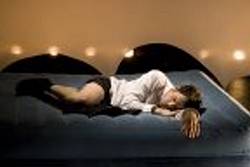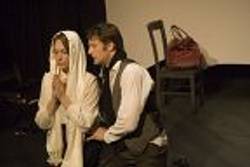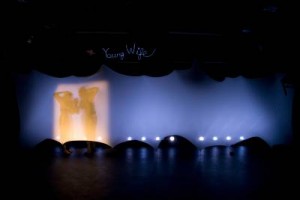
Even before the first of its ten “dialogues,” you know you’re not in for your great-great-great grandfather’s La Ronde in director Larry Biederman’s stunningly conceived, designed, and executed production of the 1900 Arthur Schnitzler classic. Despite its late-19th Century setting, there’s not a divan or gas lamp or bustle in sight. Instead, a black-and-white Annie Lennox (circa the Eurythmics) belting out “I need someone to listen to the ecstasy I’m faking” is projected on an irregularly-cut upstage canvas screen, behind which the outlines of cocktail party guests and the shadows of a man and woman move this way and that, seemingly unable to connect.
Fittingly, the only real connections made by the five men and five women in Schnitzler’s play will be brief (and sexual in nature) before they once again find themselves apart, and alone.
For those who have not seen either La Ronde, or Michael John LaChiusa’s musicalization Hello, Again (recently reviewed here), or David Hare’s modern adaptation The Blue Room, or the classic French film version, or any of the numerous movies which take Schnitzler’s circular tale as their starting point, the premise is a simple one. A woman meets a man, they have sex, they part, the man goes on to meet and mate with another woman, who then does the same with yet another man, and so on, until the final man and the first woman have the play’s climactic (no pun intended) meeting.
Biederman’s La Ronde is high concept times ten, each of the play’s brief encounters told in a style uniquely befitting the theme of each scene. Add to that Steve Barr’s stark, ingenious set design, Soojin Lee’s acid-trip ripped-up black and white modern costumes, John Eckert’s strikingly dramatic lighting, and above all John Zalewski’s pulsating “surround-sound design” and moody background music, and you have a La Ronde that is sure to be talked about.
From their first entrances, he moving right, she moving left, to don the first of their ten costumes each, Ken Barnett and Alyson Weaver never leave the stage, embodying ten distinct characters in ten distinctively staged scenes. Meanwhile, neon signs suspended from above go on one by one, indicating the arrival and departure of each character—the Prostitute, the Soldier, the Parlor Maid, the Young Gentleman, the Young Wife, the Husband, the Sweet Young Thing, the Poet, the Actress, and the Count.
The Prostitute and the Soldier’s long walk from their meeting on the Augarten Bridge to their trysting place has the two actors flirting as they cross from right to left, the stage suddenly lit bright white as the actors hurriedly reverse their steps to their point of departure, only to continue their characters’ walk from right to left, again and again until they couple. Speaking of which, sex in La Ronde ends up almost invariably of the slam, bam, thank you ma’am variety, accompanied by Zalewski’s dramatic soundtrack of loud erotic music, animalistic panting and heavy breathing.
For the scene between the Soldier and the Parlor Maid, Barnett removes four black hard-backed chairs from hooks from which they are hanging above the stage and places them in a circle, round and round which the two characters loop, playing their cat and mouse game “à la ronde.”
We meet the Parlor Maid and the Young Gentleman as they sit on separate chairs (apparently in different rooms of gentleman’s spacious home) until she is summoned to his presence by his insistent bell ringing. As the young gentleman admires the maid’s white blouse with a flirtatious “What a lovely blue,” Eckert’s lighting bathes the stage (and her blouse) in blue. When, post-coitus, the young man moves about the stage miming the opening of blinds, the stage gets brighter as each one is raised, each lighting shift accompanied by the loud electronically-heightened sound of blinds being lifted.
For the Young Gentleman’ seduction of the Young Wife, Barnett as the Husband is in constant movement, carrying the four chairs around the stage, placing them here and there, at times carrying one on each shoulder. Is it to symbolize the maze of rooms and hallways inside the couple’s hour or to emphasize his desire to control the situation? Whatever the reason, I couldn’t take my eyes away.
The scene between the Young Wife and the Husband is played entirely within a bed-sized white rectangle of light projected on the floor until, for the after-sex continuation of the scene, the white rectangle shifts to the upstage screen, behind which the two can be seen in shadow, separated once more by the expanse of “bed” between them.
Biederman has the scene between the Husband and the Sweet Young Thing begin with Barnett playing both roles, Weaver then following suit on the opposite side of the stage. Their movements choreographed like a ballet, the two actors remain separated by the expanse of stage throughout the scene.
The Sweet Young Thing’s scene with the Poet is lit almost entirely with a single flashlight (representing the script’s candle) as the Poet, chalk in hand, sketches lines and circles and words and names on the floor until the entire stage is covered with a “poem” of white chalk lines. (In one telling moment, the Poet tells the Sweet Young Thing “Yes” but writes the word No.)
Next up are the Poet and the Actress, the first part of the scene played almost entirely with Barnett and Weaver lip-synching their lines to a pre-recorded soundtrack, giving the scene the artificial quality of those 1950s/60s Italian movies recorded without live sound and post-dubbed. The scene continues with Weaver reclining on an enormous black-sheeted mattress holding a webcam to her face, her live image projected on the screen as Barnett stands in front of her image playing opposite the “movie version” of his partner.
When the Actress meets the Count, their roles are reversed, with the Count on the mattress and the Actress standing upstage playing her scene opposite the man on the screen.
Finally, the Count meets up with the Prostitute we have met in the first “dialogue,” and, in a climactic gender-bending twist, Weaver becomes the Count as Barnett reclines seductively on the mattress as the Prostitute, and the circle (aka“La Ronde”) is complete.
Biederman’s staging gives Barnett and Weaver the physical workout of their careers (particularly the former, who has to carry chairs around on his shoulders and at one point finds himself suspended horizontally between two of them, head on one, feet on the other.) Each actor creates a distinctive array of characters from the lovely Weaver’s brassy prostitute to her shy, introverted parlor maid to her flighty, flirty young wife. The charismatic Barnett shows us the soldier’s rough lustiness, the proper young gentleman’s primness, and the poet’s Byronic passion.
Biederman’s concept does tend to overpower the material at times, focusing the audience’s attention on style rather than language and thus distancing us from the characters, yet the results are quite dazzling and well worth seeing. One aspect that could stand some tweaking is the play’s length. Played straight-forward and traditionally, La Ronde would probably run about an hour and a half. Biederman’s staging stretches it to well over two hours, much too long for a one-act play. Some judicious trimming could resolve this and lead to a swifter, more involving production.
Still, this is exciting theater, and a chance to see two fine young actors, Broadway vet Barnett and 2005 USC grad Weaver, tackle challenging material staged by a visually and stylistically innovative director.
Zephyr Theatre, 7456 Melrose Ave., Los Angeles.
www.plays411.com/laronde
–Steven Stanley
January 15, 2009





 Since 2007, Steven Stanley's StageSceneLA.com has spotlighted the best in Southern California theater via reviews, interviews, and its annual StageSceneLA Scenies.
Since 2007, Steven Stanley's StageSceneLA.com has spotlighted the best in Southern California theater via reviews, interviews, and its annual StageSceneLA Scenies.







 COPYRIGHT 2024 STEVEN STANLEY :: DESIGN BY
COPYRIGHT 2024 STEVEN STANLEY :: DESIGN BY